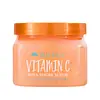What's inside
What's inside
 Key Ingredients
Key Ingredients

 Benefits
Benefits

 Concerns
Concerns

 Ingredients Side-by-side
Ingredients Side-by-side

Water
Skin ConditioningGlycerin
HumectantHydrated Silica
AbrasiveSodium Lauroyl Isethionate
CleansingStearic Acid
CleansingSodium Stearate
CleansingParfum
MaskingPunica Granatum Seed Powder
AbrasiveButyrospermum Parkii Butter
Skin ConditioningCocamidopropyl Betaine
CleansingLauric Acid
CleansingCetearyl Alcohol
EmollientMicrocrystalline Wax
Emulsion StabilisingSodium Tallowate
CleansingSodium Isethionate
CleansingPhenoxyethanol
PreservativeHydroxyacetophenone
AntioxidantSodium Cocoate
CleansingTetrasodium EDTA
Tetrasodium Etidronate
Emulsion StabilisingSodium Laureth Sulfate
CleansingCI 77491
Cosmetic ColorantCI 17200
Cosmetic ColorantCI 77492
Cosmetic ColorantWater, Glycerin, Hydrated Silica, Sodium Lauroyl Isethionate, Stearic Acid, Sodium Stearate, Parfum, Punica Granatum Seed Powder, Butyrospermum Parkii Butter, Cocamidopropyl Betaine, Lauric Acid, Cetearyl Alcohol, Microcrystalline Wax, Sodium Tallowate, Sodium Isethionate, Phenoxyethanol, Hydroxyacetophenone, Sodium Cocoate, Tetrasodium EDTA, Tetrasodium Etidronate, Sodium Laureth Sulfate, CI 77491, CI 17200, CI 77492
Sucrose
HumectantGlycerin
HumectantPolysorbate 20
EmulsifyingSilica
AbrasiveAloe Barbadensis Leaf Juice
Skin ConditioningCitrus Paradisi Peel Oil
MaskingCocos Nucifera Shell Powder
AbrasiveButyrospermum Parkii Butter
Skin ConditioningOenothera Biennis Oil
EmollientCitrus Aurantium Dulcis Peel Oil
MaskingMacadamia Ternifolia Seed Oil
EmollientPrunus Amygdalus Dulcis Oil
Skin ConditioningCarthamus Tinctorius Seed Oil
MaskingPersea Gratissima Oil
Skin ConditioningRetinyl Palmitate
Skin ConditioningAscorbic Acid
AntioxidantLactic Acid
BufferingWater
Skin ConditioningParfum
MaskingSorbic Acid
PreservativePhenoxyethanol
PreservativeCaprylyl Glycol
EmollientCI 14700
Cosmetic ColorantCI 15510
Cosmetic ColorantSucrose, Glycerin, Polysorbate 20, Silica, Aloe Barbadensis Leaf Juice, Citrus Paradisi Peel Oil, Cocos Nucifera Shell Powder, Butyrospermum Parkii Butter, Oenothera Biennis Oil, Citrus Aurantium Dulcis Peel Oil, Macadamia Ternifolia Seed Oil, Prunus Amygdalus Dulcis Oil, Carthamus Tinctorius Seed Oil, Persea Gratissima Oil, Retinyl Palmitate, Ascorbic Acid, Lactic Acid, Water, Parfum, Sorbic Acid, Phenoxyethanol, Caprylyl Glycol, CI 14700, CI 15510
 Reviews
Reviews

Ingredients Explained
These ingredients are found in both products.
Ingredients higher up in an ingredient list are typically present in a larger amount.
This ingredient is also known as shea butter. It is an effective skin hydrator and emollient.
Emollients help soothe and soften your skin. It does this by creating a protective film on your skin. This barrier helps trap moisture and keeps your skin hydrated. Emollients may be effective at treating dry or itchy skin.
Shea butter is rich in antioxidants. Antioxidants help fight free-radicals, or molecules that may harm the body. It is also full of fatty acids including stearic acid and linoleic acid. These acids help replenish the skin and keep skin moisturized.
While Shea Butter has an SPF rating of about 3-4, it is not a sunscreen replacement.
Shea butter may not be fungal acne safe. We recommend speaking with a professional if you have any concerns.
Learn more about Butyrospermum Parkii ButterGlycerin is already naturally found in your skin. It helps moisturize and protect your skin.
A study from 2016 found glycerin to be more effective as a humectant than AHAs and hyaluronic acid.
As a humectant, it helps the skin stay hydrated by pulling moisture to your skin. The low molecular weight of glycerin allows it to pull moisture into the deeper layers of your skin.
Hydrated skin improves your skin barrier; Your skin barrier helps protect against irritants and bacteria.
Glycerin has also been found to have antimicrobial and antiviral properties. Due to these properties, glycerin is often used in wound and burn treatments.
In cosmetics, glycerin is usually derived from plants such as soybean or palm. However, it can also be sourced from animals, such as tallow or animal fat.
This ingredient is organic, colorless, odorless, and non-toxic.
Glycerin is the name for this ingredient in American English. British English uses Glycerol/Glycerine.
Learn more about GlycerinParfum is a catch-all term for an ingredient or more that is used to give a scent to products.
Also called "fragrance", this ingredient can be a blend of hundreds of chemicals or plant oils. This means every product with "fragrance" or "parfum" in the ingredients list is a different mixture.
For instance, Habanolide is a proprietary trade name for a specific aroma chemical. When used as a fragrance ingredient in cosmetics, most aroma chemicals fall under the broad labeling category of “FRAGRANCE” or “PARFUM” according to EU and US regulations.
The term 'parfum' or 'fragrance' is not regulated in many countries. In many cases, it is up to the brand to define this term.
For instance, many brands choose to label themselves as "fragrance-free" because they are not using synthetic fragrances. However, their products may still contain ingredients such as essential oils that are considered a fragrance by INCI standards.
One example is Calendula flower extract. Calendula is an essential oil that still imparts a scent or 'fragrance'.
Depending on the blend, the ingredients in the mixture can cause allergies and sensitivities on the skin. Some ingredients that are known EU allergens include linalool and citronellol.
Parfum can also be used to mask or cover an unpleasant scent.
The bottom line is: not all fragrances/parfum/ingredients are created equally. If you are worried about fragrances, we recommend taking a closer look at an ingredient. And of course, we always recommend speaking with a professional.
Learn more about ParfumPhenoxyethanol is a preservative that has germicide, antimicrobial, and aromatic properties. Studies show that phenoxyethanol can prevent microbial growth. By itself, it has a scent that is similar to that of a rose.
It's often used in formulations along with Caprylyl Glycol to preserve the shelf life of products.
Water. It's the most common cosmetic ingredient of all. You'll usually see it at the top of ingredient lists, meaning that it makes up the largest part of the product.
So why is it so popular? Water most often acts as a solvent - this means that it helps dissolve other ingredients into the formulation.
You'll also recognize water as that liquid we all need to stay alive. If you see this, drink a glass of water. Stay hydrated!
Learn more about Water